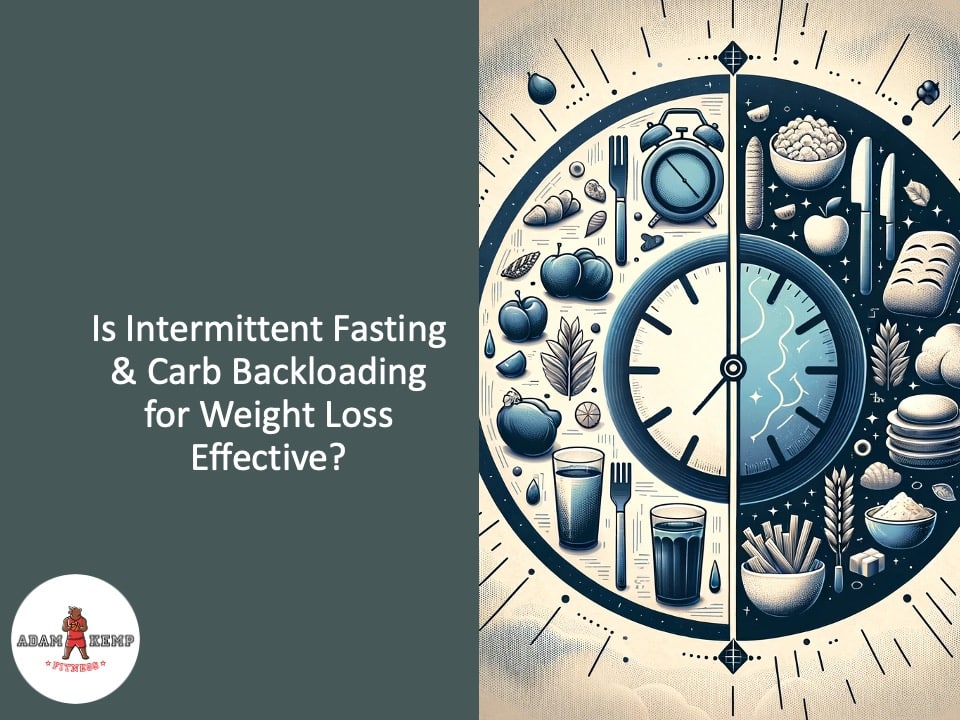Is Intermittent Fasting and Carb Backloading for Weight Loss Effective?
In the dynamic world of nutrition and wellness, the quest for effective, sustainable weight management strategies is perpetual.
Among the myriad of dietary approaches, combining Intermittent Fasting (IF) and Carb Backloading is an effective option for long-term weight management due to its simplicity, flexibility, and effectiveness for a wide-range of people.
Intermittent Fasting, a concept as ancient as it is innovative, redefines the traditional eating schedule by introducing structured periods of fasting and eating.
This approach, backed by scientific research and centuries of anecdotal success, transcends the conventional focus on ‘what to eat’, emphasizing ‘when to eat’ instead.
From the popular 16/8 method to alternate-day fasting, IF offers a spectrum of options catering to diverse lifestyles and preferences.
Carb Backloading, on the other hand, is a more contemporary strategy, predicated on the timing of carbohydrate intake.
By concentrating carbohydrate consumption towards the end of the day, particularly after physical activity, this approach aligns with the body’s natural hormonal fluctuations.
This strategic timing is designed to optimize metabolic processes, aiding in muscle recovery and reducing the likelihood of fat storage.
The convergence of Intermittent Fasting and Carb Backloading presents a compelling narrative in the realm of dietary planning.
Ready to learn more about carbohydrate backloading and intermittent fasting?
Keep reading below!
What is Intermittent Fasting?

Intermittent Fasting (IF) represents a paradigm shift in dietary practices, placing emphasis on the timing of eating and fasting periods rather than solely on food choices.
This approach encompasses various methods, such as Time-Restricted Feeding (TEF) and Fasting-Mimicking Diets (FMD), offering adaptability to suit different lifestyles.
Common IF methods include Alternate Day Fasting, the 5:2 approach (which involves five days of regular eating and two days of minimal calorie intake), and the increasingly popular 16/8 method, entailing 16 hours of fasting followed by an 8-hour eating window (Patterson & Sears, 2017).
Simplicity and Flexibility
IF is lauded for its simplicity and flexibility.
Unlike conventional diets that necessitate rigorous calorie counting or stringent food restrictions, IF pivots on the timing of food intake.
This approach endows individuals with the liberty to align their eating patterns with personal preferences and lifestyles while maintaining periods of dietary discipline (Mattson et al., 2017).
A Holistic Approach to Health
IF transcends mere weight loss, showing promising results in enhancing body composition and overall health.
It advocates for a balanced approach to nutrition, underscoring the importance of consuming nutrient-dense foods within the designated eating windows.
This nutritional balance is pivotal for sustained health and effective weight management.
Studies indicate that IF is effective in reducing fat mass, improving insulin sensitivity, and preserving muscle mass.
However, the diversity in research methodologies poses challenges in forming overarching conclusions.
Specifically, the 16/8 method has garnered attention for its beneficial impact on health markers (Sutton et al., 2018).
IF has also been recognized for its role in reducing waist circumference and positively altering fat distribution, which are crucial in mitigating the risk of metabolic disorders.
Moreover, IF has been observed to influence the gut microbiota beneficially, fostering the growth of advantageous bacterial families and thereby contributing to overall health (Gabel et al., 2018).
What is Carb Backloading?

Carb Backloading is an innovative dietary approach that strategically times carbohydrate consumption to align with the body’s natural hormonal rhythms.
Predominantly, this method involves consuming the bulk of daily carbohydrates in the latter part of the day, especially in the evening.
This timing is designed to work synergistically with the body’s hormonal fluctuations, potentially enhancing appetite control and optimizing metabolic responses, such as insulin sensitivity (Keim et al., 1995).
Aligning Carbohydrate Intake with Hormonal Fluctuations
The premise of Carb Backloading is rooted in the understanding of the body’s circadian rhythms and hormonal responses.
By consuming carbohydrates later in the day, it potentially capitalizes on the body’s natural insulin sensitivity, which tends to be higher in the afternoon and evening.
This can lead to better glycogen replenishment in muscles and reduced likelihood of fat storage.
Daily Implementation of Carb Backloading
A typical day on the Carb Backloading plan often starts with lighter meals or even a fasting period, gradually increasing caloric intake as the day progresses.
The day usually culminates in a carb-rich meal in the evening, ideally after physical activity.
This approach not only aligns with hormonal rhythms but also supports muscle recovery and growth, particularly after exercise.
For individuals who engage in morning workouts, Carb Backloading can be adapted to include a post-exercise carbohydrate intake.
This modification ensures effective muscle recovery post-training while still benefiting from the Carb Backloading strategy later in the day.
It’s a flexible approach that can be tailored to individual training schedules and dietary preferences.
Benefits of Combining Intermittent Fasting and Carb Backloading for Weight Loss
Merging the principles of Intermittent Fasting (IF) with Carb Backloading presents a dynamic strategy that caters to those aiming for weight loss, muscle building, and overall wellness.
This dual approach harnesses the strengths of both methods, creating a nuanced dietary framework that can be customized according to individual health goals and lifestyle patterns.
When combining IF and Carb Backloading, it’s crucial to understand how these methods complement each other:
- Enhanced Metabolic Flexibility: IF’s fasting periods help in improving insulin sensitivity and promoting fat burning. When followed by Carb Backloading, particularly after exercise, the body is primed to utilize carbohydrates more efficiently for muscle repair and growth, rather than fat storage.
- Optimal Energy Utilization: The fasting phase in IF can lead to increased fat oxidation, while the strategic timing of carbohydrate intake in Carb Backloading ensures that these macronutrients are used effectively for energy replenishment and muscle recovery, especially post-workout.
- Customization for Lifestyle and Fitness Goals: Depending on personal schedules and fitness routines, this combination allows for flexibility. For instance, those who work out in the morning might opt for a post-exercise carb meal, while still adhering to the fasting window of IF for the rest of the day.
How to Combine Intermittent Fasting and Carb Backloading for Weight Loss
- Consultation with a Healthcare Professional: Before embarking on this dietary journey, especially for individuals with health conditions or unique nutritional needs, it is advisable to consult a healthcare provider. This ensures safety and helps tailor the approach to individual health profiles.
- Choosing the Right IF Method: There are several IF patterns, such as the 16/8 method, 5:2 approach, or alternate-day fasting. Selecting one that aligns with your daily routine and physical activity level is crucial for sustainability and effectiveness.
- Timing and Quality of Carbohydrate Intake: In Carb Backloading, focus on the quality of carbohydrates – opting for complex carbs like whole grains, legumes, and vegetables. The timing should align with the individual’s training schedule, ideally post-workout, to maximize muscle glycogen replenishment and minimize fat gain.
- Balanced Nutritional Intake: Ensuring a balanced diet is essential. This includes adequate protein for muscle repair, healthy fats for hormonal balance, and micronutrients from a variety of food sources. Hydration should also be a priority, particularly during fasting periods. Planning a few go-to healthy dinner ideas with quality carbs and lean protein can make this process easier and more sustainable.
- Listening to Your Body: It’s important to be attentive to how your body responds to this combined approach. Adjustments might be necessary based on energy levels, workout performance, and overall well-being.
- Consistency and Patience: Like any dietary change, consistency is key. Allow time for your body to adapt to this new eating pattern. Track progress and make changes as needed, keeping long-term health and fitness goals in mind.
Integrating Intermittent Fasting with Carb Backloading offers a holistic and adaptable framework for nutrition and health.
By understanding the synergies between these two methods and tailoring them to individual needs and goals, one can embark on a sustainable journey towards improved health, better body composition, and enhanced physical performance.
With mindful implementation and adherence, this combined approach can be a transformative tool in one’s wellness repertoire.
For more information, check out this video to hear about one special success story made possible by intermittent fasting!
Potential Risks & Considerations of Combining Intermittent Fasting and Carb Backloading
While Intermittent Fasting (IF) and Carb Backloading present themselves as promising strategies for weight management and health improvement, it is vital to acknowledge and address potential risks and considerations associated with these dietary approaches.
Altered Eating Patterns and Mood Changes
One of the primary concerns with IF is the potential alteration in normal eating patterns, which could lead to mood changes, especially during fasting periods.
Fasting can influence mood-regulating neurotransmitters, potentially leading to feelings of irritability or lethargy in some individuals (Michalsen & Li, 2013).
Additionally, abrupt changes in eating patterns may initially disrupt regular bodily functions and cause discomfort.
Exercise Timing Challenges
Integrating exercise into IF and Carb Backloading regimes can present challenges.
Training during fasting windows might affect energy levels and exercise performance.
Research suggests that exercise performance can be impaired during fasting, though adaptations over time may mitigate these effects (Chaouachi et al., 2009).
It’s important for individuals to listen to their bodies and potentially adjust workout intensities and timings to align with their energy levels during fasting periods.
Importance of Balanced Nutrient Intake
Maintaining a balanced nutrient intake is critical in both IF and Carb Backloading.
Neglecting this balance can lead to nutritional deficiencies, impacting overall health.
Furthermore, prolonged fasting periods, if not managed correctly, might lead to muscle protein breakdown, underscoring the importance of adequate protein intake and timing, especially for active individuals (Tinsley & La Bounty, 2015).
Ensuring a diet rich in a variety of nutrients, including vitamins, minerals, and essential fatty acids, is essential for sustaining long-term health and preventing potential negative outcomes.
Preventing Extended Periods of Starvation
It is crucial to distinguish between healthful fasting practices and extended periods of starvation, which can be detrimental.
Starvation can lead to muscle loss and a decrease in metabolic rate, which is counterproductive to the goals of IF and Carb Backloading (Varady et al., 2009).
Therefore, it is vital to structure fasting periods appropriately and ensure they are followed by nutrient-rich meals to support overall health and well-being.
Final Thoughts: Should You Combine Intermittent Fasting with Carb Backloading for Weight Loss?
The fusion of Intermittent Fasting (IF) and Carb Backloading represents more than just a dietary trend; it’s a thoughtful approach towards achieving a harmonious balance between physical health and lifestyle preferences.
This combination offers a unique avenue for individuals to explore their dietary choices, aligning them with personal health goals, be it weight loss, muscle building, or overall well-being.
Here are a few final takeaways you should be aware of when considering intermittent fasting and carb backloading:
- Customization is Paramount: The beauty of combining IF with Carb Backloading lies in its adaptability. Tailoring these methods to fit personal routines, exercise schedules, and nutritional needs is crucial for long-term success and satisfaction.
- Health Beyond Weight Loss: While weight management is a significant benefit, the impact of this dual approach extends to improved metabolic health, better insulin sensitivity, and enhanced muscle recovery. It’s a strategy that nurtures the body as much as it reshapes it.
- Mindful Eating and Lifestyle Integration: This method encourages a mindful approach to eating, focusing on not just what and how much you eat, but also when you eat. It’s a holistic strategy that integrates seamlessly into various lifestyles, promoting a sustainable path to health.
- Empowerment Through Education: Understanding the science behind IF and Carb Backloading empowers individuals to make informed choices. It’s an invitation to become more attuned to the body’s needs and responses, fostering a deeper connection with one’s health journey.
- The Importance of Professional Guidance: Consulting healthcare professionals ensures that this approach is aligned with individual health conditions and nutritional requirements, offering a safe and effective route to dietary success.
- Patience and Persistence: As with any lifestyle change, patience and consistency are vital. Adapting to new eating patterns might take time, and results may vary. It’s a journey of discovery and learning, one step at a time.
Read Next: Intermittent Fasting for Weight Loss



